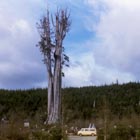
The Nolan Creek cedar on the Olympic Peninsula in Washington, one of the largest known specimens. This 1987 photo shows the tree shortly after the entire surrounding stand had been clearcut. As of 2018, the tree remains healthy and is now emergent from a stand of young Tsuga heterophylla [C.J. Earle, 1987.04.04].

Me and Bob Van Pelt measuring the "Big Mother Cedar" in Clayoquot Sound, British Columbia [Adrian Dorst, 1999.12].
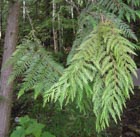
Foliar units on a tree at Christina Lake, British Columbia [C.J. Earle, 2009.08.14].
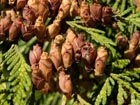
Cones and foliage on a tree in Olympia, Washington [C.J. Earle, 2009.10.06].

A spray of foliage, 15 cm long, upper side [C.J. Earle, 2019.05.16].

A spray of foliage, 15 cm long, lower side [C.J. Earle, 2019.05.16].
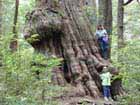
A moderately large tree in the Long Island grove, Washington [C.J. Earle, 2002.06.15].

Harvesting inner bark of redcedar [Dr. Linda B. Brubaker].

Bundles of gathered bark [Dr. Linda B. Brubaker].
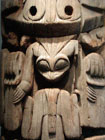
Western redcedar is generally the preferred material for totem poles. This detail of a Haida pole at the University of British Columbia Anthropological Museum shows Bear with a frog in his throat [C.J. Earle, 2002.02.16].
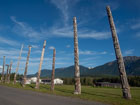
One of the greatest collections of in-situ (more or less) totem poles is at the Gitxsan village of Gitwangak, British Columbia, on the northern bank of the Skeena River [C.J. Earle, 2011.07.06].

Cultural materials made from redcedar wood: bentwood boxes and utensils [Dr. Linda B. Brubaker].

This is another species (Sequoia is probably the most famous one) that people like to drive through. This tree originally grew by the old highway 99 west of Arlington, Washington. In 1893 the tree died in a fire and in 1916 the drive-through tunnel was cut. Since 1971 it has stood at the northbound rest area on Interstate 5 near Arlington [C.J. Earle, 2017.08.05].

A pleasant path winds through the Bernard DeVoto Cedar Grove in Idaho [C.J. Earle, 1977.05.20].

Conservation Status

Thuja plicata
Donn ex D. Don in Lambert 1824
Common names
Western or giant redcedar, giant arborvitae, shinglewood, canoe cedar (Peattie 1950).
Taxonomic notes
Syn: Thuja gigantea (Silba 1986).
Description
Trees to 50(-70) m tall and 200(-600) cm dbh, often buttressed at base, with a conical to irregular crown; old specimens frequently have many leaders and many dead spike tops. Bark red-brown or (particularly when exposed to sunlight) gray-brown, 10-25 mm thick, fibrous with shallow longitudinal fissures, easily peeled. Branches arching, branchlets pendent in planar (slightly concave downward) sprays 15-50 cm long × 5-15 cm wide, each spray representing 1-2 years' growth, a spray consisting of a central shoot and 14-30 alternate lateral shoots (see image at right). Foliar morphology differs between sun and shade foliage. Shade leaves scale-like, decurrent, opposite in 4 ranks, each leaf green, glabrous, 1-6 mm long including decurrent base (shortest at tips, longest at base of shoot), acute to abruptly acuminate, often mucronate; stomata forming an irregular patch on the lower side of each leaf. Sun foliage differs in that sprays are more flexible and less planar, with smallest shoots upturned and nearly round. Second-year twigs brown, sheathed in dead leaves that are mostly fallen from the 3rd-year and older twigs, which are smooth, lustrous red-brown aging to dark grey, fibrous bark becoming noticeable on branches more than about 2 cm diameter. Pollen cones 1-3 mm, borne in a cup formed by two leaf pairs at the tips of lateral spray branchlets. Pollen cones are most abundant on sun foliage. Seed cones are borne in the medial region of lateral spray branchlets, ellipsoid, composed of 4 pairs of scales (2-3 fertile pairs) arranged in 4 ranks, 10-12 mm long and about half as wide when dry and fully opened, each with a nearly terminal deltate projection. Seeds 8-14 per cone, 4-7.5 mm (including wings), reddish brown. 2n = 22. Wood reddish, fragrant, light, with a very straight grain (Chambers 1993, pers. obs.). See García Esteban et al. (2004) for a detailed characterization of the wood anatomy.
In habitat, this tree is most likely to be confused with Callitropsis nootkatensis. Mature trees are easily distinguished by their bark (gray in T. plicata, nearly white in C. nootkatensis) and the seed cones are very distinct (bilaterally symmetrical in T. plicata, nearly globose in C. nootkatensis). The foliage is bifacially flattened and the foliar units (sprays) have many alternate lateral shoots in T. plicata; in C. nootkatensis the branchlets are 4-angled and the foliar units have fewer lateral shoots and, generally, are less symmetrical in form.
Distribution and Ecology
USA: Alaska, Montana, Idaho, Washington, Oregon and California; Canada: British Columbia, Alberta; at 0-1500 (2000) m elevation. Topographically, this represents a Coast Range-Cascade Range segment from southeastern Alaska to northwestern California (between 56° 30' and 40° 30' N latitude) and a Rocky Mountains segment from British Columbia to Idaho and Montana (between 54° 30' and 45° 50' N latitude). Found on various substrates, commonly on moist sites, in mixed coniferous forests (Chambers 1993). Hardy to Zone 6 (cold hardiness limit between -23.2°C and -17.8°C) (Bannister and Neuner 2001). See also Thompson et al. (1999).
Distribution data from USGS (1999).
Remarkable Specimens
The largest known tree is the Cheewhat Lake Cedar on the west coast of Vancouver Island (an area that can generally be described as the happy hunting ground for giant redcedars), which has a wood volume of 449 cubic meters, a dbh of 584 cm, and a height of 55.5 m. The tallest known is 71.3 m for a tree near the Grove of the Patriarchs in Mt. Rainier National Park, measured a few years before 1996 (Van Pelt 1996, with a 2018 email confirmation); this tree is believed to still be alive, though a remeasurement would be useful. Van Pelt also reports the second-tallest tree on record, 69.7 m, in a study plot at Carbon River, Mount Rainier National Park (Van Pelt email 2018.07.19). Also noteworthy is the Willaby Creek tree, south of Lake Quinault in the Olympic Mountains of Washington, also accessed by trail, 59.4 m tall with a wood volume of 351 cubic meters (Van Pelt 2001). Until late July of 2016, the largest known was the Quinault Lake Cedar, located closely north of Quinault Lake, which once had an estimated wood volume of 500 cubic meters (if you discount the enormous hollow center, where I once stood with over 20 other people), with a dbh of 594 cm and height of 53.0 meters. It was easily accessed by an interpretive trail, now officially closed but shown on pre-2016 maps. Another former giant of note, the Kalaloch Cedar, just off Highway 101 in the Olympic National Park, with a dbh of 599 cm and wood volume of 350 cubic meters, was destroyed by a storm in March 2014.
The oldest recorded tree, on Canoe Creek in Olympic National Forest, was cored and provided a ring count of 1460 years (pers. comm. Robert Van Pelt, 1999.07.28). There is also a record of 1212 years for a partial sample from a tree at Cheewhat Lake, Pacific Rim National Park, BC, collected by Randy Stoltmann (Van Pelt 1998). In general, there are not many data for this species; the largest and presumably oldest trees represent complex growth patterns on many different buttresses, and accurately determining the age of most old trees would require a complete stump section and a lengthy exercise in measurement and crossdating--assuming that the central part of the tree had not rotted away, as it often has.
Ethnobotany
"Redcedar has been called 'the cornerstone of northwest coast Indian culture' and the large-scale use of its wood and bark delineates the cultural boundary of the northwest coast peoples within its range. ... Few cedar trees were actually felled before European contact. Instead, fallen logs or boards split from standing trees were used. To split off cedar boards for house planks or half-logs for canoes, a series of graduated yew-wood [Taxus brevifolia] or antler wedges were pounded into living trees along the grain.
The power of the redcedar tree was said to be so strong a person could receive strength by standing with his or her back to the tree. Redcedar was used for a variety of ailments. It is called the 'tree of life' by the Kakawaka'wakw and is still held with highest respect by all northwest coast peoples for its healing and spiritual powers. A Coast Salish myth says the Great Spirit created redcedar in honour of a man who was always helping others: 'When he dies and where he is buried, a cedar tree will grow and be useful to the people -- the roots for baskets, the bark for clothing, the wood for shelter' " (Pojar and Mackinnon 1994).
To appreciate the material, medical and spiritual value of cedar to Northwest Coast peoples, consider the diversity of uses cited by Gunther in her 1945 review of ethnobotany among surviving western Washington native peoples:
"Throughout the whole Northwest the wood most extensively used by the Indians is cedar. House planks, house posts, roof boards, and canoes are made exclusively of this wood. Boxes, including those with bent sides [see photo], and dugouts [canoes] are of cedar. ... The Quileute make the hearth of the fire drill of cedar, as well as the spindle for spinning mountain-goat wool. The Squaxin make the herring rake of cedar. The charcoal of cedar wood mixed with salmon eggs is used by the Quinault to rub on canoe paddles, which are held in pitch wood smoke and then rubbed with green grass to produce a lasting shiny black.
"Equally as useful as the wood is the bark of the cedar tree [see photos], in fact there is no single item so ubiquitous in the Indian household. The shredding of bark is a constant bit of busy work for women, done by the Chehalis with a deer-bone chopper. It is shredded fine enough to be used as padding for infants' cradles, as sanitary pads, as towels. A coarser grade is plaited into skirts and capes, later into complete dresses for women. The Lower Chehalis use cedar bark for clothing, while the Upper Chehalis depend more on skins, a situation duplicated whenever a tribe is divided into a salt-water and an up-river group. Shredded bark is used for ceremonial head bands ... In its unshredded state cedar bark is cut in strips of varying widths, the broader ones plaited to serve as dishes or as individual plates, as used by the Cowlitz, who also interweave cedar and maple to make larger platters. They also use cedar bark to line cooking pits. A small, coarse, twilled mat is used by several Puget Sound tribes for laying out boiled salmon. Canoe bailers are folded of large pieces of cedar bark and lashed with wild cherry bark. Wads of shredded cedar bark are used as tinder for fires and also carried in a slow torch on journeys. The narrower strips are woven into mats by the Makah. ... The lining and head band of the rain hat were made of split cedar by the Quinault, Quileute, and Makah. The Quileute string dried clams and smelts for storage on strips of cedar bark. For many purposes cedar bark is dyed with alder juice to give it a rich red-brown color.
"The limbs of the cedar tree are stripped of their leaves, soaked in water, and twisted into rope. The heavier grades are used by the whale-hunting tribes like the Quinault, Quileute, and Makah for towing home dead whales. It has remarkable strength. Single limbs which have been worked to pliability are used to tie or sew the corners of wooden boxes and tie cross pieces in canoes. The Quileute string pecten shells on a small cedar limb as a dance rattle. Cedar limbs are used for openwork baskets by the Quinault and Squaxin, and also for weaving with vine maple sticks for fish weirs, and by the Snuqualmi for tying the poles of the summer house.
"The roots of the cedar tree are used widely, in both western and eastern Washington, for the coiled and imbricated basket. They are split fine and used for the foundation, then trimmed more carefully for the sewing element. The only part of this area where cedar is not used for basketry is on the Pacific coast from the Quinault northward, where spruce [Picea sitchensis] is substituted. In searching for roots for basketry, the Squaxin were anxious to get those lying under rotten logs. Roots are also used by the Quinault for sewing the corners of wooden boxes.
"Medicine: The Lummi chew the buds of cedar and swallow them for sore lungs, while the Cowlitz chew them for toothache, and the Skokomish boil them for a gargle. The Skagit boil the ends of the leaves for coughs. The Cowlitz boil the tips and mix them with some roots... for a cold medicine. The Klallam boil cedar limbs for tuberculosis medicine. The Chehalis peel the bark of a small tree, and the inner part is chewed or boiled and the liquid drunk to help bring about menstruation [unless] pregnancy was suspected ... The Quinault make an infusion of the bark and twigs for kidney trouble. The seeds of cedar are steeped with the ends of the limbs and the infusion drunk to break a fever. The Quinault boil an infusion of cedar limbs to wash sores due to venereal diseases.
"In addition to these medicinal uses, the leaves and limbs of cedar are used for scouring the body in bathing, both for ordinary purposes and in preparation for ceremonial occasions. This was mentioned by Swan and also by present-day informants. Among the Lummi, a boy takes the boughs he has used to rub himself before a guardian spirit quest and fastens them to the top of a cedar tree. Whalers put piles of cedar branches under their beds to make themselves ready for the hunt and to ward off bad luck.
"There is a strong association between cedar and death. Lummi men, burying a corpse, chew cedar tips to avoid nausea. Cedar limbs, singed, were used by the Lummi as a broom to sweep off the walls of a house after the removal of the corpse. The Skagit burned cedar limbs at night and waved them through the house to scare the ghost after death" (Gunther 1945).
To the modern world, redcedar "is an important timber tree. Its soft but extremely durable wood is valued for home construction, production of shakes and shingles, and many other uses. Many cultivars are grown for ornament, and the species is managed for timber in Europe and New Zealand." (Chambers 1993).
The wood and pollen are said to be quite allegenic for some people.
Western redcedar is the provincial tree of British Columbia (Pojar and Mackinnon 1994).
My 2019 review of the literature found limited use of dendrochronology to assess tree decline and growth response to climate, but in general, the species has not been useful, mainly due to poor circuit uniformity. Yamaguchi used death dates of snags to date seismic events on the Washington coast (Atwater et al. 1991).
Observations
Although single-species stands of redcedar are relatively uncommon, their cathedral qualities make them some of the most majestic forests of North America.
- The outstanding example is the stands in the Pacific Rim National Park area on the west coast of Vancouver Island, British Columbia. This low-lying mosaic of swamps and estuaries represents a habitat long since destroyed in the U.S. by logging, and is (unlike many similar forests in BC) readily accessible. One fine stand is laced by a nature trail near where Highway 4 reaches the coast. I believe this is the Rainforest Trail in Pacific Rim National Park (49.0415°N, 125.6811°W).
- In the U.S., what is often described as the finest remaining stand of old-growth cedar can be found on Long Island in Willapa Bay, Washington (approximately 46.425°N, 123.954°W).
- Some cedar stands in the interior west are also very beautiful, although they do not contain extremely large trees. I recommend the DeVoto Memorial Cedar Grove (46.53925°N, 114.67553°W) in northern Idaho, though it also grows along Lake McDonald in Glacier National Park, Montana (where the western redcedar is the main design motif in Lake McDonald Lodge).
- The species is also readily found in Olympic National Park, Mount Rainier National Park and North Cascades National Park in Washington.
Remarks
The epithet plicata means "folded" and refers to the shape of the leaves, which resemble origami folds.
T. plicata produces organic compounds called tropolones that are concentrated in the heartwood and give the wood its decay resistance and contribute to its distinctive aroma (DeBell et al. 1997).
Citations
Atwater, B.F., M. Stuiver, and D.K. Yamaguchi. 1991. Radiocarbon test of earthquake magnitude at the Cascadia subduction zone. Nature 353:156-158.
DeBell, J.D., J.J. Morrell, and B.L. Gartner. 1997. Tropolone content of increment cores as an indicator of decay resistance in western redcedar. Wood and Fiber Science 29(4):364-369. Abstract: The high decay resistance of western redcedar (Thuja plicata Donn) is due to the presence of toxic extractives, called tropolones, in the heartwood. Therefore, tropolone content may be used as an indicator of decay resistance. With increment core-sized samples of western redcedar heartwood, we used gas chromatography to measure tropolone content and soil block tests to assess decay resistance. Results showed that decay resistance was extremely variable at low tropolone levels, but was uniformly high at tropolone levels of 0.25% or greater. Analyzing tropolone content of western redcedar increment cores is a useful way to assess decay resistance of standing trees.
Lambert, A. B. 1824. A description of the genus Pinus, V. 2, P. 19.
Van Pelt, Robert. 1996. Champion Trees of Washington State. Seattle, Washington: University of Washington Press.
See also
Burns and Honkala (1990).
Elwes and Henry 1906-1913 at the Biodiversity Heritage Library (Photos). This series of volumes, privately printed, provides some of the most engaging descriptions of conifers ever published. Although they only treat species cultivated in the U.K. and Ireland, and the taxonomy is a bit dated, still these accounts are thorough, treating such topics as species description, range, varieties, exceptionally old or tall specimens, remarkable trees, and cultivation. Despite being over a century old, they are generally accurate, and are illustrated with some remarkable photographs and lithographs.
Farjon (2005).
Grescoe, A. and B. Herger. 1997. Giants: the colossal trees of Pacific North America. Boulder, CO: Roberts Rinehart.
Harrington, C. A. (tech. coord.). 2010. A tale of two cedars: International symposium on western redcedar and yellow-cedar.. U.S. Forest Service General Technical Report PNW-GTR-828.
Contains significant papers on ethnobotany, ecology and distribution, soil nutrient dynamics, dendrochronology, responses to fungal attack, mortality, climate change, wood extracts, growth, and responses to varied silvicultural treatments.
MacKinnon et al. (1992).
Stewart, Hilary. 1984. Cedar: Tree of Life to the Northwest Coast Indians. Vancouver: Douglas & McIntyre.














